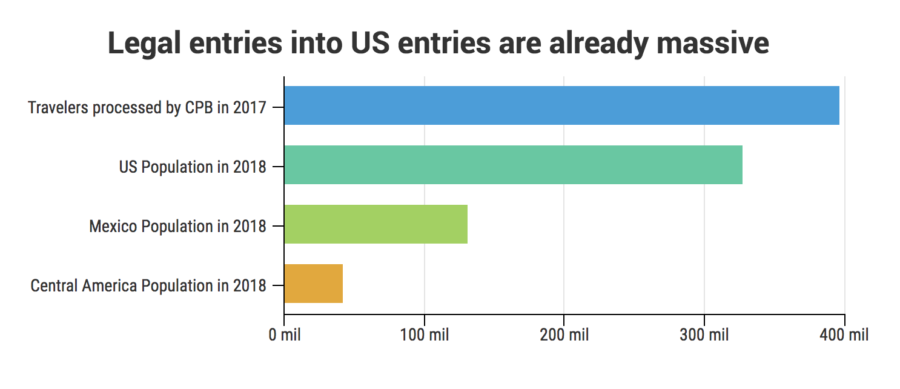Planes, Boats and Concealed Vehicles: The reality of drug trafficking at the border
Infographic of the number of entries into the United States via legal points of entry in 2017 versus the total populations of the US, Mexico, and Central America. Source: Customs and Border Patrol, United States Census Bureau. By Kian Nassre, Web Editor
Amidst the recent government shutdown and the trials of Joaquín “El Chapo” Guzmán for smuggling drugs into the U.S., President Trump’s petition for building a wall at the U.S.-Mexico border has grown intensely. Despite his campaign promise to build the multibillion-dollar wall in 2016, the wall has still not received funding and large sections of the border remain unmonitored.
According to a report by Vox, on Dec 22, 2018, Trump announced a government shutdown that halted everything from national park care to paychecks for over 800,000 federal workers. He initially refused to end the shutdown until over $5 billion was allocated to funding the wall. In the wake of the United States’ longest and most expensive government shutdown of 35 days and over $11 billion, national parks were unmaintained, airports experienced waves of confusion and federal workers didn’t receive paychecks for weeks. The shutdown temporarily ended on Jan. 25th when President Trump and various government departments agreed to fund a range of government departments such as the USDA and FDA through Feb. 15th. During this break, negotiations and conversations about funding for the border wall will continue. 35 days and 11 billion dollars later, President Trump’s proposed wall still lingers only as a goal. While the shutdown ended on Jan 25th, 2019, Trump did not abandon his pledge for a wall and continued with a storm of tweets in support of the wall as well as a video that ended with “Build the wall.”
In addition to President Trump’s initial emphasis on the wall preventing crime and illegal immigration, he has highlighted its potential to lower drug trafficking as well. He claimed in a tweet on Jan 11th, 2019, that the wall, referred to as a “Steel Barrier,” would end the “pouring in” of drugs which “can be stopped cold.”
Trump’s tweet implies that drugs are being trafficked and transported through open and unmonitored areas of the border, which, according to the U.S. Drug Enforcement Administration (DEA) reports, is generally incorrect.
According to a 2017 report by The Government Accountability Office, well over 80 percent of drugs that enter The United States do so through official points of entry, which means that increasing security by a wall would not decrease the amount of drugs that already enter through legal checkpoints. This fact was confirmed in El Chapo’s recent trials, as the Mexican drug lord has moved over 200 tons of illegal drugs through regulated checkpoints into the U.S.
In addition, according to a 2017 report written by the DEA, illegal drugs are most often being transported through “fishing boats, trains, tractor-trailers and ordinary cars.” The majority of drugs coming from countries with high rates of trafficking, such as Colombia, come in by plane and by boat.
According to the same 2017 DEA report, “The most common method employed by these TCOs (Transnational Criminal Organization) involves transporting illicit drugs through U.S. ports of entry (POEs) in passenger vehicles with concealed compartments or commingled with legitimate goods on tractor trailers.” Essentially, if drugs continue to be transported into the U.S. by the same means, extending security through a wall will not address the lack of attention at existing checkpoints.
Earlier last month during the government shutdown, President Trump commented on civilian deaths by overdoses and said: “These numbers will be DRASTICALLY REDUCED if we have a Wall!” He later followed this with a speech in which he stated that “if we build a powerful and fully designed see-through steel barrier on our southern border, the crime rate and drug problem in our country would be quickly and greatly reduced.”
As opposed to closing and regulating more of the border, bigger problems lie in the regulation of existing checkpoints. According to an article in Daily Beast, only about 18 percent of vehicles that cross through these checkpoints are searched by customs agents. Increasing agents at these checkpoints and supporting those already working would help to increase regulation. But as opposed to improving existing systems, President Trump maintains his push for billions of dollars to construct a wall two years after he promised it to millions of Americans.


